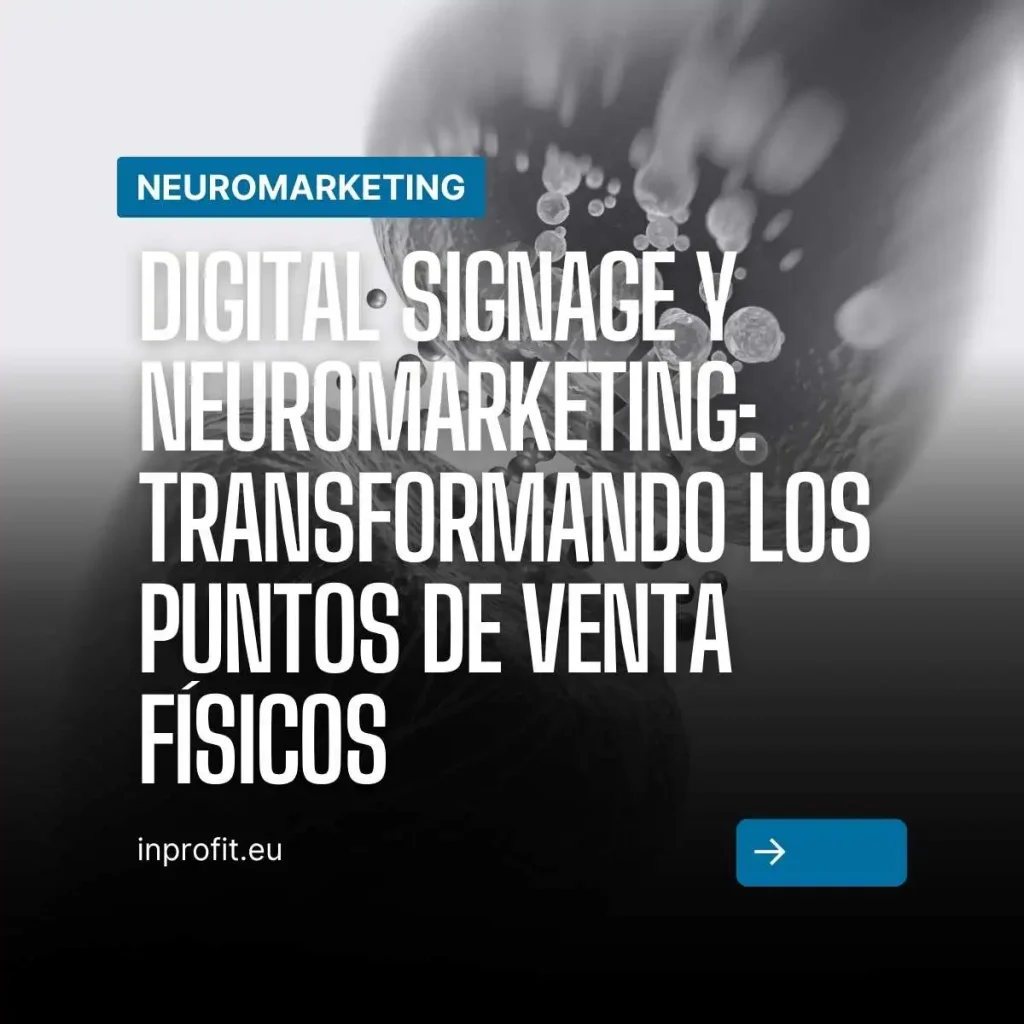Digital signage combined with neuromarketing principles is revolutionizing the way brands interact with customers in physical stores, creating immersive experiences that not only engage, but also drive purchase decisions.
This article explores how these two disciplines merge to optimize physical POS, with practical examples, benefits and strategies for successful implementation.
What is Digital Signage and how does it relate to Neuromarketing?
El digital signage se refiere al uso de pantallas digitales (como monitores, videowalls o quioscos interactivos) para mostrar contenido dinámico, como anuncios, promociones, videos o información en tiempo real, en espacios físicos. A diferencia de los carteles estáticos tradicionales, el digital signage permite actualizar contenido al instante, adaptarlo a audiencias específicas y medir su impacto.
Neuromarketing studies how the human brain responds to marketing stimuli, using neuroscience insights to design strategies that appeal to consumers’ emotions, memory and instincts. By combining digital signage with neuromarketing, brands can create visual messages that trigger emotional and subconscious responses, increasing the likelihood of conversion at the point of sale.
This synergy is especially powerful in physical environments, where consumers make quick decisions influenced by factors such as colors, sounds, images and the context of the environment. Below, we break down how these tools work together to transform retail outlets.
The basis of Neuromarketing applied to Digital Signage
El neuromarketing se basa en entender cómo el cerebro procesa estímulos para influir en el comportamiento. Algunos principios clave que se pueden aplicar al digital signage incluyen:
- Visual attention and the primacy effect: The human brain is programmed to notice dynamic and novel visual stimuli. Digital displays that change content, use animations or vibrant colors capture attention faster than static posters. For example, a screen showing a video of a product in action can activate the brain’s visual attention system, increasing the likelihood that the consumer will stop and look.
- Emotions and storytelling: Purchasing decisions are driven by emotions rather than logic. Digital signage can tell visual stories that connect emotionally with consumers, such as a video showing a family enjoying a product in a warm and relatable environment.
- Scarcity and urgency effect: Neuromarketing has shown that the perception of scarcity (such as “only 3 units left”) activates the brain’s reward system. Digital displays can show offer timers or “limited stock” messages to generate urgency.
- Sensory anchoring: Multisensory stimuli (visual, auditory, tactile) reinforce memorability. For example, combining a digital display with ambient music or in-store fragrances can anchor the brand experience in the consumer’s mind.
- Cognitive simplicity: The brain prefers clear, easy-to-process messages. Digital signage should use clean designs, legible typography and concise messages to avoid cognitive overload.
The relationship with physical points of sale
La combinación de estas herramientas ofrece múltiples ventajas para las tiendas físicas:
- Increased attention and engagement: Dynamic digital displays capture consumers’ attention in an environment full of distractions. A Nielsen study found that 68% of consumers remember ads on digital screens better than on static billboards.
- Real-time personalization: Digital signage allows content to be adapted according to the time of day, weather or customer profile. For example, a coffee shop can display breakfast in the morning and cold drinks in the afternoon, appealing to the immediate needs of the consumer.
- Driving impulse purchases: Messages designed with neuromarketing principles, such as warm colors (red, orange) or phrases that generate urgency, can increase unplanned purchases. For example, a display next to the cash register promoting a “special combo” can increase the average ticket.
- Improved in-store experience: Interactive displays, such as touch kiosks, allow customers to browse products, check availability or even customize orders, creating a more immersive experience.
- Measurement and optimization: Modern digital signage solutions integrate data analytics, such as cameras that detect customer attention time or clicks on touch screens, allowing you to measure impact and adjust strategies in real time.
Practical strategies for implementing digital signage
1. Design emotionally impactful content
- Usa videos o imágenes que evoquen emociones positivas, como felicidad o nostalgia. Por ejemplo, una tienda de ropa puede mostrar un video de personas disfrutando de un día soleado con sus prendas, apelando al deseo de libertad y estilo de vida.
- Apply colors according to the objective: red for urgency, blue for confidence, green for sustainability.
- Include testimonials or customer reviews on screens to trigger social proof, a neuromarketing principle that reinforces trust.
2. Place screens strategically
- Place displays in high-attention areas, such as entrances, main aisles or waiting areas (e.g., near the cash register).
- Use eye-tracking (if available) to identify where customers are looking and adjust the position of the screens.
- Install interactive displays in key decision areas, such as near high-margin products, to guide customers to specific purchases.
3. Create messages with urgency and scarcity
- Displays countdown timers for limited promotions, such as “Offer valid today only”.
- Highlight messages such as “Last units” or “Limited edition” to trigger the fear of missing out (FOMO).
4. Take advantage of contextual personalization
- Integrate external data, such as weather or local events, to display relevant content. For example, a sports store can promote raincoats on rainy days.
- Uses technologies such as facial recognition (with consent) to personalize messages based on the customer’s age or gender.
5. Combines multisensory stimuli
- Sincroniza el contenido de las pantallas con música ambiental o aromas que refuercen la experiencia. Por ejemplo, una pantalla que promociona perfumes puede activarse junto con un dispensador de fragancias en la tienda.
- Use touch screens to allow customers to interact with content, such as customizing products or browsing catalogs.
6. Continuously measure and optimize
- Configure digital signage systems with analytics capabilities to track metrics such as attention time, clicks or direct conversions.
- Perform A/B tests with different messages, colors or formats to determine which combinations generate the greatest impact.
- Use tools such as Google Analytics (integrated with e-commerce) to correlate the impact of digital signage with in-store sales.
A use case brought to reality
- Fashion retail: A clothing store installs a video wall at the entrance showing a fashion show with its latest collections. The video uses vibrant colors and energetic music to capture attention, while a “20% off today only” message generates urgency. Result: 15% increase in sales of the featured collection.
- Supermarkets A supermarket places touch screens in the wine aisle, where customers can search for recommendations based on their budget or preferences. Messages include phrases such as “Perfect for your dinner tonight”, appealing to emotion. Result: 25% increase in sales of premium wines.
- Fast-food restaurants: One chain uses digital displays in the ordering area to show customized combos based on the time of day, with images of food that trigger hunger (warm colors, close-ups). A “Offer valid for 10 minutes” timer drives impulse purchases. Result: 10% increase in average ticket.
- Pharmacies: A pharmacy installs interactive kiosks where customers can scan products to view additional information, such as benefits or reviews. The screens highlight products with “High Demand” to trigger social proof. Result: increased engagement and sales of personal care products.
POS Marketing What’s coming?
El avance de tecnologías como la inteligencia artificial (IA), el aprendizaje automático y la realidad aumentada (AR) está llevando el POS Marketing al siguiente nivel. En el futuro, veremos:
- Personalized AI displays: Displays that adjust content in real time based on the customer’s profile, using data from loyalty programs or previous interactions.
- AR integration: Customers can “try on” products virtually through interactive displays, such as makeup or clothing.
- Advanced analytics: AI cameras that measure facial emotions (with consent) to evaluate the effectiveness of messages in real time.
- Sustainability: Low energy consumption displays and content focused on sustainable values, aligned with modern consumer preferences.
The combination of digital signage and neuromarketing is transforming physical retail outlets into dynamic and emotionally immersive spaces. By applying neuroscience principles, such as visual attention, urgency and storytelling, brands can capture consumers’ attention, influence their purchasing decisions and create memorable experiences.
Desde pantallas interactivas hasta mensajes personalizados en tiempo real, estas herramientas ofrecen una ventaja competitiva en un entorno minorista cada vez más digital.
To implement this strategy, start with an analysis of your target audience and the key points of your store. Invest in a scalable digital signage system, design content based on neuromarketing principles and measure results continuously.
With this combination, you will not only improve sales, but also strengthen the emotional connection with your customers, ensuring their long-term loyalty.
If you’re ready to explore digital signage, check out vendors like Samsung, LG or cloud-based solutions like Yodeck or ScreenCloud – transform your point of sale into an experience consumers won’t forget!




